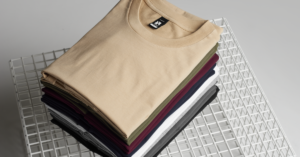The production process of clothing and printing is constantly changing, and with the growing concern for environmental practices, natural methods (including natural dyes) are becoming more frequently used.
As the name “natural dye’ suggests, the ingredients of natural dyes are found from natural sources – such as plants, fruits, animals, insects, and naturally occurring minerals. There are many reasons why choosing natural dye is a great idea, but as with any technique or preference – there are disadvantages too.
In this blog post we’ll outline the various pros and cons to using natural dyes, so you can make the decision as to whether you’d like to use them or not, fully informed. As with any process and business decision, if you’re considering changing your technique or changing your process, it’s key to do as much research as possible.
Advantages of Natural Dyes
Below we’ve listed the main advantages to using natural clothing dyes. As you can see, there are many advantages, mainly those concerning carbon footprints or environment / social responsbility.
Minimal Environmental Impact – Natural dyes come from the earth, instead of from a science lab, so the contents are much better for the environment. Sourcing natural dyes has less carbon footprint (in most cases) than man-made dyes, and natural dyes are usually biodegradable too.
Renewable – Most natural dyes are usually obtained from renewable sources and natural sources, so they’re very easy to source and can be harnessed without causing any (or very little) harm to the environment. For people who want to keep their brand eco-friendly and environmentally conscious, this is a huge selling point.
Colour effect – For brands that want a softer effect, or a softer hue in their colouring, natural dyes are really good for providing that.
Less Chemicals – For many people this is a big factor in their decision, as a lot of people react badly to man-made dye because of the chemicals or ingredients inside. Opting for natural dyes can help counter this, as the ingredients are natural so considered less ‘harsh’.
Generally Safe / Less risk – For natural dyes used in makeup products (such as lipsticks for example) the natural dyes are much safer in cases of accidental ingestion.
Disadvantages of natural dyes
Whilst there are many pros to using natural dyes, there are some drawbacks too. As we want to be as fair as possible in this article, and to give you as much information as possible, here are the disadvantages to natural dyes.
Cost / quantity – Whereas synthetic dyes seem to go quite far (and can cover larger portions of fabric) a natural dye can’t. A larger amount of natural dye would be needed to cover the same space of synthetic dye, which can sometimes mean prices are higher and synthetic dyes are often more budget friendly.
The colour effects – Natural dyes may fade quicker than their synthetic alternative. The colour pay-off may also not be right for all projects (as it has a much softer effect).
Availability – Nature is natural – which can mean things go in and out of season, and sometimes things may not be available. When you put this in the context of natural dye, it means that sometimes (or at some times of the year) the dye might be harder to come by as availability might be lower than usual. This can also put prices up, which can be frustrating for smaller businesses.
Harmful Effects – Whilst natural dye doesn’t necessarily contain harmful chemicals, there have been ingredients found in natural dyes that may not be beneficial. There shouldn’t be anything to worry about when wearing properly made garments, but (for example) it’s worth bearing in mind that natural dyes may need mordants for application (it helps the dye stick to the fabric) – which can be toxic. Some examples of mordants used in natural dyes are aluminium, copper, iron, and chrome.
Sustainability – Whilst natural dyes are renewable, they do create a slight sustainability issue, because the dye is being pulled from natural sources (which need sustaining in order to stay maintained).




